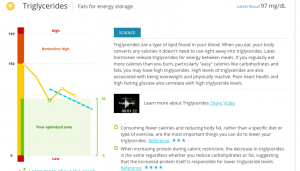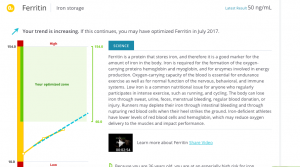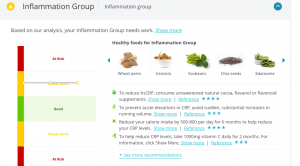If you’ve been reading a while, you know I’m a fan of Inside Tracker. I’ve written posts about my first test and my second test, and you can learn a lot about how the service works in those posts. In short, you go get a blood draw, and in a few days, you get your results and all sorts of data from Inside Tracker. What I love is that they don’t just look at what’s considered “healthy” by your doctor, but they’re also looking at what is optimal for an athlete.
It’s been a year since I’ve done tests (though I did input some data from a doctor ordered test at my annual physical last summer), and my diet hasn’t been so great as of late, so I was interested to see how the results would play out. Turns out, the numbers were better than expected, but I still have some solid work to do.
I’ve got a number of things in optimal zones, but here I’m just going to talk about where things aren’t optimal, because I believe that this is where Inside Tracker truly shows its worth.

Note – you can click on any of these to see more.
So my blood sugar is trending up. This isn’t a surprise. I had done a really good job of watching my general sugar intake and lately, I’ve been finding jelly beans stored in my pocket. So that needs to stop.
My cholesterol is down from my last test, but that was from a doctor’s test that I input myself, and it wasn’t a fasting blood test. That said, it’s still up from my last Inside Tracker test, and that’s not something I like to see. Much of this is genetics (joy of joys), but I can absolutely do some work on this.
Similar results with my LDL, though I’m closer to where I was at my last Inside Tracker test.
Rounding out cholesterol, we’ve got HDL and Triglycerides. Nothing in the optimal range, but I’m working on it, but at least I’m in the officially “healthy” range.
What’s key about all of these? One big way to help these numbers is to lose body fat. And this is exactly why I work on weight loss. Or more importantly, fat loss. I’m huge on accepting your body for what it is and not worrying about your weight. But on the other hand, you also have to accept your health. As Inside Tracker says, Blood Don’t Lie. I’m confident there are people much heavier than me who have much better results on their blood tests, so it’s not solely weight – genetics plays a huge role here. But for me, if I want to get my body into those optimal zones, I need to continue to whittle off the excess fat.
Step one, fewer jelly beans in my pockets.
Ferritin is a number that I’ve been working on, and you can see how the change in my diet has been increasing that number every so slightly.
B12 isn’t trending in the right direction, and I think this one might be where I look into supplements. I don’t really want to add octopus or beef liver to my diet right now.
I’ve seen pretty much no change in my Inflammation Group, which tells me that what I’m doing isn’t working. I’m not any worse off than I was, but I’m also no better. Once again, one of the options is reducing calorie intake, which hey, I’ll be doing anyway. This might also be where I look into supplements. I’m wary of adding too many supplements, but Vitamin C isn’t a bad one. I usually only add additional Vitamin C when the plague hits my office, but maybe it’s time to make that an every day thing.
In general, I’m going to research some more supplements. This is an area where you can’t just say “Hey, I’ll take a pill for that,” because supplements aren’t all created equal. I’ve already decided to add spirulina, because as long as you’re taking a supplement that’s free of contaminants (do your research), there aren’t any side effects. Other supplements don’t work in the same way, so it’s worth doing the research and talking to a medical professional.
Full disclosure – as a member of Team Coeur, I get a discount on Inside Tracker tests, so I paid a discounted rate for this test, but as you can see, I’ve been a fan of the company from well before I started to receive a discount. All opinions are my own. As was the blood.
The post Inside Tracker – March 2017 Tests appeared first on Elbowglitter.







Geen opmerkingen:
Een reactie posten